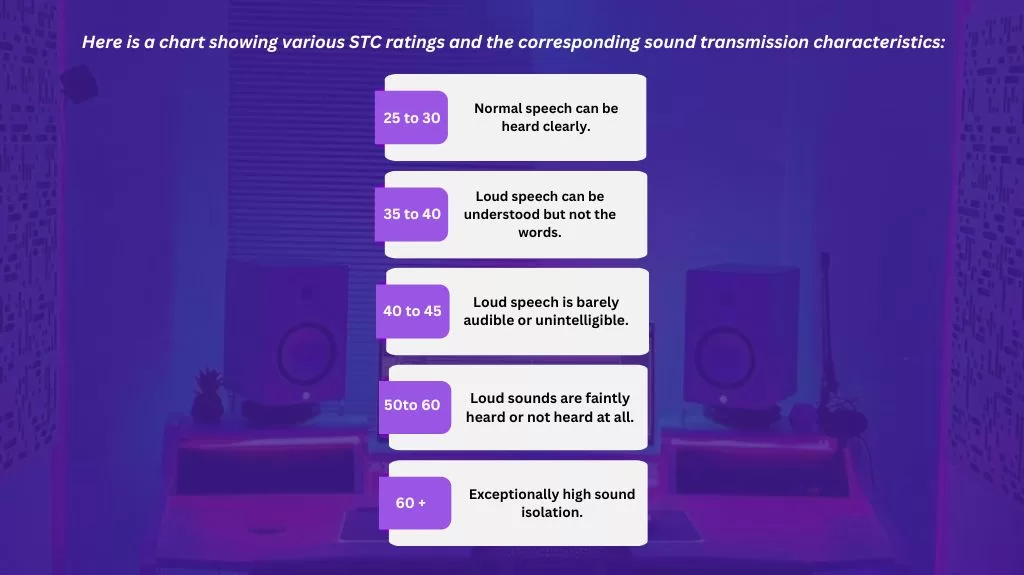Table of Contents
1. STC Rating Introduction
When it comes to designing or constructing a building, one crucial factor that often goes unnoticed is sound transmission. Unwanted noise can significantly impact the comfort and productivity of the occupants. This is where the STC rating plays a vital role. In this article, we will delve into the world of STC rating, understanding its significance, calculation methods, and how it influences building design.
2. What is STC Rating?
STC stands for Sound Transmission Class, which is a numerical rating used to quantify how well a building element, such as a wall or door, can reduce sound transmission. It provides an objective measurement of a material’s or assembly’s ability to block airborne sounds like voices, music, or traffic noise. A higher STC rating indicates better soundproofing capabilities.
3. How is STC Rating Calculated?
The STC rating is determined through a series of acoustical tests conducted in a laboratory. The test involves measuring the sound transmission loss across a range of frequencies. The resulting data is then plotted on a graph, and the STC rating is determined based on the curve’s characteristics.
4. Importance of STC Rating
Understanding the STC rating is crucial for creating acoustically comfortable spaces. Whether it’s in residential buildings, offices, or educational institutions, maintaining privacy and reducing noise disturbances is essential. By considering the STC rating during construction or renovation, architects and builders can create environments that promote tranquility and enhance overall well-being.
5. Factors Affecting STC Rating
Several factors influence the STC rating of a building element. Let’s explore some of the key aspects that can impact sound transmission.
Building Materials
The type and quality of materials used in constructing walls, windows, doors, floors, and ceilings greatly influence their STC rating. Dense and solid materials like concrete, brick, and gypsum board offer better sound insulation compared to lightweight materials.
Construction Techniques
The construction techniques employed also play a significant role in achieving desirable STC ratings. Proper sealing of gaps, minimising flanking paths, and ensuring airtightness can help reduce sound transmission.
Airborne and Impact Sounds
STC ratings are based on the transmission of airborne sounds, such as speech or music. However, impact sounds, such as footsteps or furniture movements, can also affect acoustic performance. Incorporating additional measures to address impact noise is necessary for comprehensive soundproofing.
6. Common STC Ratings for Building Elements
Different building elements have varying STC ratings. Here are some typical STC ratings for commonly used components:
Walls
- Standard interior wall: STC 30-35
- Insulated interior wall: STC 40-45
- Exterior wall: STC 45-50
Windows
- Single-pane window: STC 20-25
- Double-pane window: STC 25-35
- Soundproof window: STC 45-50
Doors
- Hollow-core door: STC 15-20
- Solid wood door: STC 25-30
- Soundproof door: STC 40-45
Floors
- Standard wood or concrete floor: STC 25-30
- Soundproofed floor with underlayment: STC 50-55
Ceilings
- Standard ceiling: STC 25-30
- Acoustic drop ceiling: STC 40-45
7. Achieving Better STC Ratings
To enhance the STC rating of a building element, several soundproofing techniques can be employed. These techniques aim to minimise sound transmission and improve acoustic performance.
Soundproofing Techniques
- Decoupling: Creating air gaps or using resilient channels between surfaces to prevent sound vibrations from transferring.
- Mass and Density: Adding mass to walls, floors, or ceilings by using dense materials or additional layers.
- Damping: Incorporating sound-damping materials like acoustic sealants or viscoelastic layers to reduce vibrations.
Acoustic Insulation
Installing high-quality acoustic insulation within wall cavities, ceilings, or floors can significantly enhance soundproofing capabilities.
Soundproofing Materials
Using specialised soundproofing materials, such as soundproof drywall, acoustic panels, or sound-absorbing foams, can further improve STC ratings.
8. Benefits of High STC Ratings
Buildings with higher STC ratings offer numerous benefits. These include:
- Enhanced privacy: Higher STC ratings reduce sound transmission, ensuring conversations and activities remain confidential.
- Improved focus and productivity: Lower noise levels contribute to better concentration and productivity in workplaces and educational settings.
- Restful environments: Reduced external noise enhances relaxation and improves sleep quality in residential buildings.
9. Limitations of STC Ratings
While the STC rating provides valuable information, it is important to note its limitations. STC ratings are determined under laboratory conditions and do not account for real-world factors such as flanking paths or sound leakage through electrical outlets. Additionally, STC ratings focus on airborne sounds and may not accurately represent the transmission of low-frequency sounds or impact noise.
10. STC Rating and Building Codes
Many building codes and regulations include minimum STC requirements for different building elements. Compliance with these codes ensures a certain level of sound insulation and acoustic performance in buildings. Architects and contractors must consider the STC rating guidelines when designing or renovating structures.
11. Conclusion
The STC rating serves as a valuable tool in creating acoustically comfortable spaces. By understanding the concept of sound transmission class, considering the factors influencing the rating, and employing appropriate soundproofing techniques, architects and builders can significantly enhance the acoustic performance of buildings. Prioritising sound insulation leads to increased privacy, improved focus, and overall well-being of the occupants.
FAQs
Q: What does STC stand for?
A: STC stands for Sound Transmission Class.
Q: Can STC rating be improved?
A: Yes, the STC rating can be improved by using soundproofing techniques, adding mass and density to building elements, and using specialised soundproofing materials.
Q: How do I measure the STC rating of a material?
A: The STC rating is determined through laboratory testing, where the sound transmission loss across a range of frequencies is measured.
Q: Is higher STC rating always better?
A: While a higher STC rating generally indicates better soundproofing capabilities, it’s important to consider other factors such as flanking paths and impact noise.
Q: Are there international standards for STC ratings?
A: Yes, there are international standards and guidelines for STC ratings, which vary across different countries and regions.

